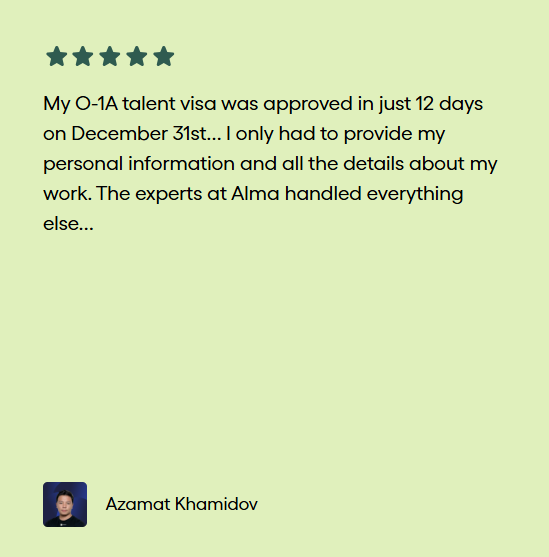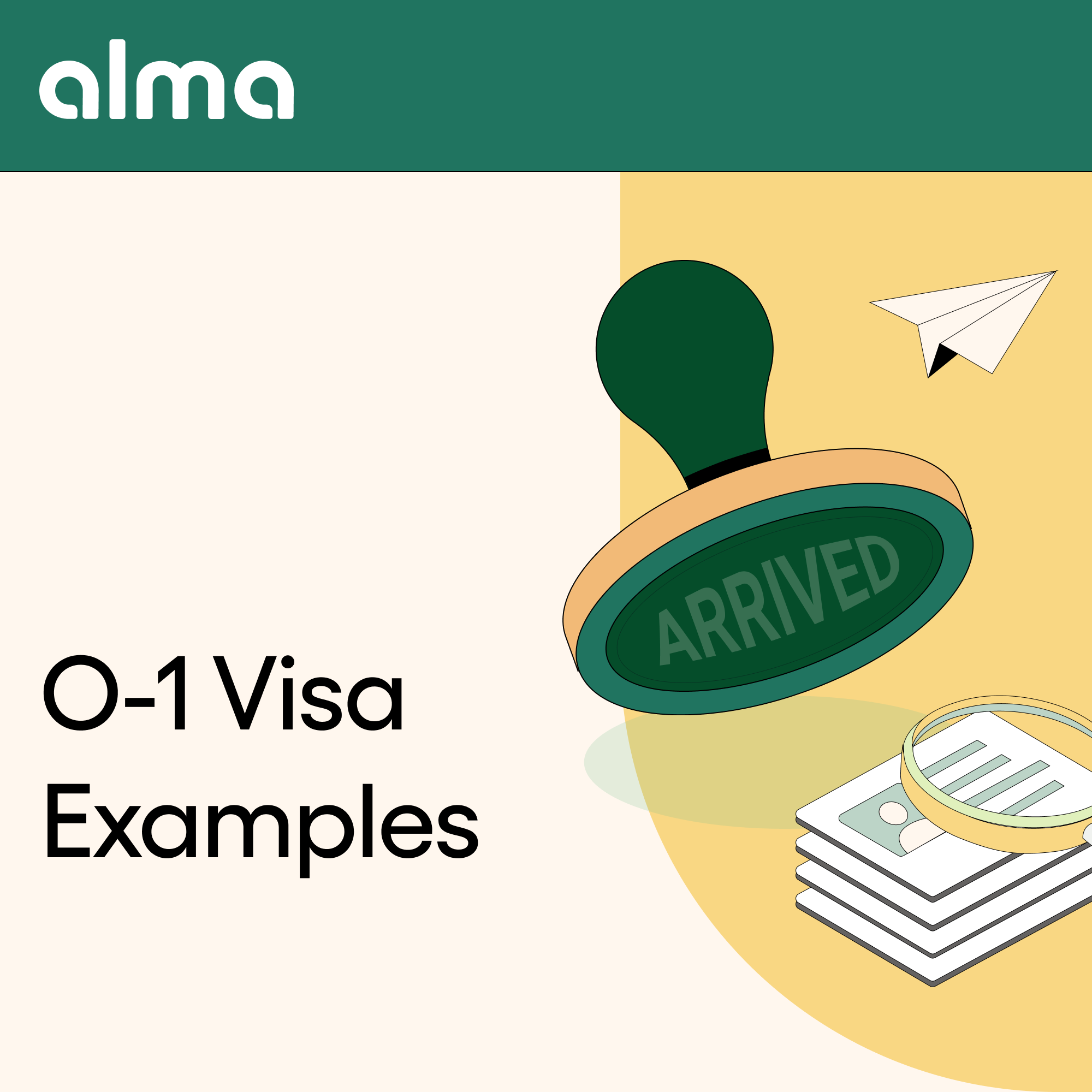- The O-1 approval rate has consistently exceeded 90% since 2020.
- That rate reflects the O-1 visa’s strict criteria, high evidentiary bar, and highly qualified applicant pool.
- To qualify, you must show sustained national or international acclaim or meet at least 3 of 8 O-1A categories (or 3 of 6 for the O-1B) per USCIS.
The O-1 visa is designed for individuals who have demonstrated exceptional ability and outstanding achievements in fields such as science, business, the arts, or sports. While approval rates have remained consistently high (ranging from 90% to 94% for the O-1A from 2018 to 2023), the visa’s strict eligibility standards make it accessible only to a select group.
The chart below shows quarterly approval rates from 2024 and 2025, based on data from U.S. Citizenship and Immigration Services (USCIS):

At first glance, it might seem like obtaining an O-1 is straightforward. But the standards required to qualify for the O-1 visa are high and demand extensive evidence of a petitioner’s extraordinary ability.
In this guide, we’ll explore the reasons behind the O-1’s approval rates and the advantages this visa holds over other nonimmigrant visas.
Why Is the O-1 Visa Approval Rate High?
The O-1 visa approval rate is high largely because of the visa’s demanding eligibility criteria. The bar is set so high that only a small pool of people qualify in the first place. And those who do apply are typically already in strong standing, with profiles that align closely with USCIS expectations.
In general, you must demonstrate sustained national or international recognition and acclaim:
- For the O-1A (sciences, education, business, or athletics), this means meeting at least three of eight USCIS-defined criteria.
- For the O-1B (arts, motion picture, and television industry), it means meeting at least three of six criteria.
Below are the eight USCIS criteria for O-1A eligibility, along with examples of how a petitioner may meet them:
Below are the six USCIS criteria for O-1B eligibility, along with examples of how a petitioner may meet them:
The O-1 visa can’t be self-petitioned — you need a U.S. employer or agent to sponsor and file on your behalf. That adds steps that some otherwise qualified people aren’t ready (or able) to take.
For founders, a co-founder, board member, or another authorized representative of your company can file the O-1 visa petition on your behalf. However, the petitioner must prove a legitimate employer–employee relationship with the company.
Finally, the application process takes time and requires extensive documentation. Strong O-1 visa applications typically run 500–700 pages, and for many applicants, the time and volume involved can be a significant hurdle.
The required documents typically include:
- A written consultation from someone with expertise in the field (e.g., a peer group or labor organization).
- A written work contract or proof of a job offer (often an employment agreement with company formation documents).
- A detailed list of planned work and activities, along with recommendation letters from experts in the field.
- A supporting statement outlining eligibility under the selected criteria, with all evidence attached.
Strong O-1 visa applications usually include five to six letters of recommendation.
What O-1 Extraordinary Ability Can Look Like
Below are two brief examples of successful cases we’ve handled.
The first involved an early-stage founder and AI engineer who applied for — and secured — an O-1A visa. He had previously founded and worked at several companies, including a brainwave-data startup selected for a life-science incubator and backed by a California accelerator.
Alma positioned his innovative AI work in a way that clearly aligned with the O-1A eligibility criteria.

Alma also successfully helped a classically trained singer obtain an O-1B visa. She had become known for introducing a new kind of sound in the industry, blending operatic singing with modern music production techniques. Her performances attracted millions of views online and on TV competitions, and she had collaborated with Grammy-winning producers.
Alma worked closely with her to assemble a full portfolio demonstrating her experience and extraordinary ability under the O-1B criteria.
Both cases reflect the range of professional backgrounds that can qualify under the O-1 visa framework.
What Are the Advantages of the O-1 Visa?
The O-1 visa comes with several benefits that are rare among non-immigrant visas:
- You can apply at any time, with the only restriction being that you cannot file Form I-129 (your petition) with USCIS more than six months before your intended start date.
- You’re approved for an initial stay of up to three years, with the ability to renew annually as long as your work in the field continues.
- With the O-1A, you can own and run a business — and that business can sponsor your visa.
- There’s no minimum education requirement, no wage requirement, and no annual cap or lottery.
- It offers unlimited extensions, the ability to work for multiple employers, and a potential pathway to an EB-1 Green Card if you meet further criteria.
Compare this with the H-1B visa for foreign nationals in specialty occupations, which comes with an annual visa cap and lottery, wage requirements, limited validity, and strict start dates.
Get Personalized Guidance from Alma
At Alma, every case is handled directly by an immigration lawyer with more than 10 years of experience — never paralegals or offshore teams. In your first consultation, you’ll get an upfront assessment of whether your case is likely to meet USCIS approval standards.
From there, you’ll be onboarded to our in-house platform, which streamlines the entire application process. You can securely upload documents, track progress, and receive automatic notifications and updates. You’ll also have direct email and phone access to your assigned immigration lawyer for tailored legal advice throughout the process.
The entire process — from signing on with us to receiving visa approval — is typically accomplished within four to six weeks, while most other firms take four to seven months. Once we have all of your required documentation, our turnaround time to filing with USCIS is usually two to three weeks.
Our attorneys have deep industry knowledge and know how to frame your accomplishments to clearly meet O-1 criteria. We pride ourselves on exceptional responsiveness and support that truly sets us apart.
We also offer a 99%+ success rate for getting petitioner visas approved. You can explore our growing list of client success stories.

We also guarantee a single flat fee for the entire application process, with no hidden costs for responding to requests for evidence (RFEs) or refiling your O-1 visa application if needed.
Schedule a free immigration consultation to discuss your potential fit for the O-1 visa based on your experience.
Frequently Asked Questions
Factors include the strength and organization of your documentation, the credibility of your credentials and achievements, the presence of a qualified U.S. sponsor (since the O-1 is employment-based), the nature of your field, and broader U.S. immigration policies and adjudication trends.
While processing times vary depending on case complexity and workload, it generally takes four to six months for U.S. Citizenship and Immigration Services to process an O-1 visa petition.
If you opt for premium processing, your U.S. visa's processing time is expedited to a 15-day turnaround.
Note that "processing time" refers only to the USCIS review period — it doesn’t include the time needed to prepare the O-1 visa application.
Yes, O-1 visa holders can bring their immediate family to the United States. The O-3 visa is available to the spouse and unmarried children of O-1 or O-2 visa holders. The O-2 visa, on the other hand, is for individuals who need to accompany an O-1 visa holder for an artistic or athletic performance and who have essential skills and experience of their own.
As long as the O-1 visa remains valid, O-3 dependents can live and study in the U.S., but are not permitted to work during their stay.





.png)
.jpg)

